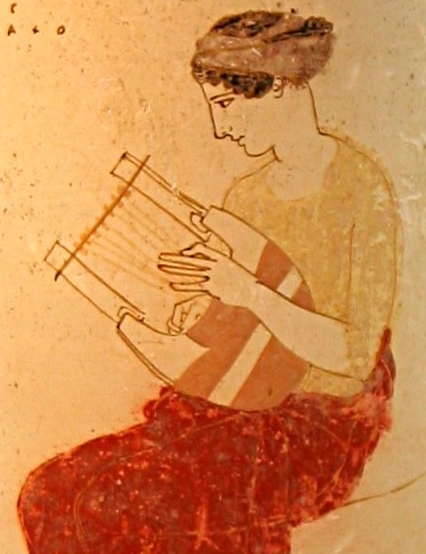lyra / lyre
A plucked string instrument often played by amateurs in Classical times. It had gut strings and had a body made from the shell of a tortoise.

The lyre is a simple stringed instrument, and the basis of the earliest recorded written music-theory, on Babylonian tablets c.2000 BC.
The Greek lyre was typically constructed of a tortoise shell for the soundbox, with three wooden dowels attached to which the strings were attached.
The ancient Greeks similarly wrote much of their music theoretical information in reference to the lyre, and their note-names refer directly to the positions of the strings on the lyre. The strings were positioned exactly as on the modern guitar, with the lowest-pitched string closest to the player's body and the highest-pitched string furthest away.
The oldest Greek scale had 7 notes which were named as shown below in descending pitch order; note that this scale is composed of two conjunct (_synemmenon_) tetrachords with identical intervallic structure -- that is, the lowest note of the highest tetrachord is the same pitch as the highest note of the lower tetrachord:
----------- note name ------------ modern interval
Greek transliteration English equiv. between
νητη nete furthest D \
> tone \
παρανητη paranete next-to-furthest C \
> tone upper tetrachord
τριτη trite third Bb /
> semitone /
μεση mese middle A <
> tone \
λιχανοσ lichanos index-finger G \
> tone lower tetrachord
παρυπατη parhypate next-to-nearest F /
> semitone /
'υπατη hypate nearest E /
Another basic scale was created by raising all four strings of the higher tetrachord a tone, resulting in a new highest note and also inserting a new note a tone above _mese_. Note that the tetrachords still have the same intervallic structure, but this time they are disjunct (_diezeugmenon_), separated by the "tone of disjunction":
----------- note name ------------ modern interval
Greek transliteration English equiv. between
νητη nete furthest E \
> tone \
παρανητη paranete next-to-furthest D \
> tone upper tetrachord
τριτη trite third C /
> semitone /
παραμεση paramese next-to-middle B
> tone of disjunction
μεση mese middle A
> tone \
λιχανοσ lichanos index-finger G \
> tone lower tetrachord
παρυπατη parhypate next-to-nearest F /
> semitone /
'υπατη hypate nearest E /
Later, another conjoined tetrachord was added below the 7-note scale, and to the 8-note scale conjoined tetrachords were added both at the bottom and the top. With the addition of the "added tone" (_proslambanomenos_) at the bottom, this created respectively the Lesser Perfect System (LPS) and Greater Perfect System (GPS). The note names of the highest (_hyperbolaion_) tetrachord were the same as those of the upper tetrachord of the original scales, and the note names of the lowest (_hypaton_) tetrachord were the same as those of the lower tetrachord of the original scale.
The tonalsoft.com website is almost entirely the work of one person: me, Joe Monzo. Please reward me for my knowledge and effort by choosing your preferred level of financial support. Thank you.
